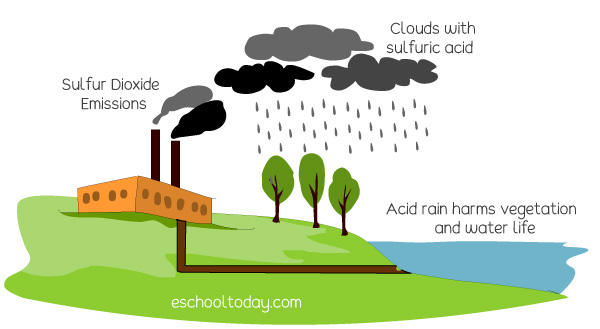- Air Pollution
What are the effects of air pollution?
Below are a few effects of air pollution. The last page on FactSheet has some specific air pollution incidents that are worth checking out.
Acidification:
Chemical reactions involving air pollutants can create acidic compounds that can cause harm to vegetation and buildings. Sometimes, when an air pollutant, such as sulfuric acid, combines with the water droplets that make up clouds, the water droplets become acidic, forming acid rain. When acid rain falls over an area, it can kill trees and harm animals, fish, and other wildlife.

Acid rain destroys the leaves of plants.
When acid rain infiltrates into soils, it changes the chemistry of the soil, making it unfit for many living things that depend on the soil as a habitat or for nutrition. Acid rain also changes the chemistry of the lakes and streams that the rainwater flows into, harming fish and other aquatic life.
Eutrophication:
Rain can carry and deposit the Nitrogen in some pollutants on rivers and soils. That will adversely affect the nutrients in the soil and water bodies. It can result in algae growth in lakes and water bodies and make conditions for other living organisms harmful.
Ground-level ozone:
Chemical reactions involving air pollutants create poisonous gas ozone (O3). Gas Ozone can affect people’s health and can damage vegetation types and some animal life too.
Particulate matter:
Air pollutants can be in the form of particulate matter that can be very harmful to our health. The level of effect usually depends on the length of time of exposure, the sort, and concentration of chemicals, and the particles exposed. Short-term effects include irritation to the eyes, nose, and throat, and upper respiratory infections such as bronchitis and pneumonia. Others include headaches, nausea, and allergic reactions. Short-term air pollution can aggravate the medical conditions of individuals with asthma and emphysema. Long-term health effects can include chronic respiratory disease, lung cancer, heart disease, and even damage to the brain, nerves, liver, or kidneys. Continual exposure to air pollution affects the lungs of growing children and may aggravate or complicate medical conditions in the elderly.
NOTES
- Particulate matter can come in almost any shape or size and can be solid particles or very tiny liquid droplets.
- Big particles can be between 2.5 and 10 micrometers (about 25 to 100 times thinner than a human hair).
- Small particles are smaller than 2.5 micrometers (100 times thinner than a human hair).
